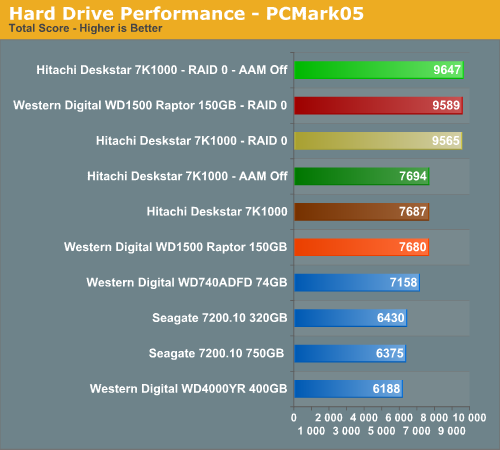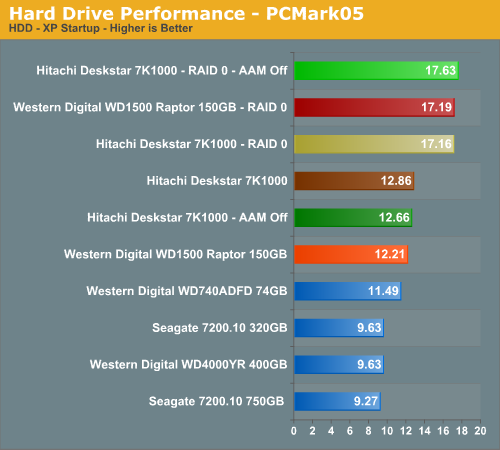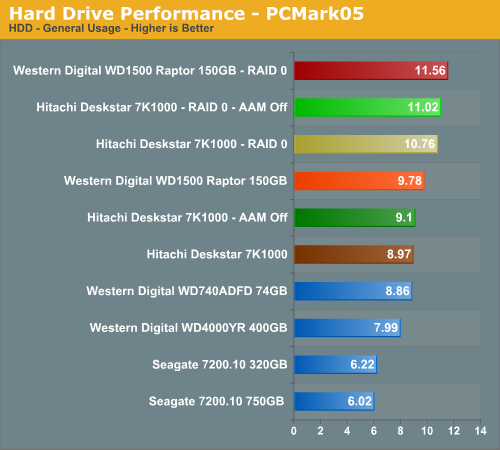Hitachi Deskstar 7K1000 in RAID 0: Is Two Terabytes really better than One?
by Gary Key on April 19, 2007 12:15 AM EST- Posted in
- Storage
Hard Disk Performance: PCMark05
We are utilizing the HDD test suite within PCMark05 for further comparative hard disk scores as it provides a mixture of actual application results and specific read/write percentages utilized within these programs. It is also a readily available benchmark that others can use for comparative purposes. The program utilizes the RankDisk application within the Intel iPeak SPT suite of tools to record a trace of disk activity during usage of real world applications. These traces are then replayed to generate performance measurements based upon the actual disk operations within each application. The HDD test suite contains 53% read and 47% write operations with each trace section utilizing varied amounts of read or write operations. Additional information about the test suite can be found in PDF format here PCMark05 whitepaper.
The PCMark05 test results are based upon the following trace runs:
Windows XP Startup: This test consists of 90% reading and 10% writes that tracks XP activities at start-up.
Application Loading: This test consists of 83% reading and 17% writes that tracks the opening and closing of the following programs.
File Write: This test consists of 100% write activities by writing 680MB of files onto the hard disk.






Our PCMark05 RAID 0 results show a 25% improvement over the single Hitachi drive results. The 7K1000 combination still scores better than the WD 150GB Raptor setup in this benchmark provided AAM is turned off, although the differences are minor. The major performance delta between the 7K1000 single and RAID 0 configuration is in the Windows Startup and File Write tests. As a side test that we are still developing, we tracked our actual XP startup times with each configuration. The RAID 0 setups only improved startup times by a few tenths of a second in most cases.
We fully expected the File Write tests to show major improvements as this is an area where RAID 0 will show an advantage. We see minor differences occurring in the General Usage and Application Loading sections of the test where write and read operations are balanced to a certain degree.
The Raptor's superior rotational/access speeds allow it to basically score slightly better than the 7K1000 except in the Virus Scan test where the 7K1000 has exceptional scores, even though it still lags behind the Seagate drive. Overall, if you need to improve your PCMark05 benchmark scores then RAID 0 will certainly do that, but as evidenced in the General Usage and Application results which mimic actual applications there is minimal impact.
We are utilizing the HDD test suite within PCMark05 for further comparative hard disk scores as it provides a mixture of actual application results and specific read/write percentages utilized within these programs. It is also a readily available benchmark that others can use for comparative purposes. The program utilizes the RankDisk application within the Intel iPeak SPT suite of tools to record a trace of disk activity during usage of real world applications. These traces are then replayed to generate performance measurements based upon the actual disk operations within each application. The HDD test suite contains 53% read and 47% write operations with each trace section utilizing varied amounts of read or write operations. Additional information about the test suite can be found in PDF format here PCMark05 whitepaper.
The PCMark05 test results are based upon the following trace runs:
Windows XP Startup: This test consists of 90% reading and 10% writes that tracks XP activities at start-up.
Application Loading: This test consists of 83% reading and 17% writes that tracks the opening and closing of the following programs.
- Microsoft Word
- Adobe Acrobat Reader
- Windows Media Player
- 3Dmark 2001SE
- Leadtek WinFast DVD
- Mozilla Internet Browser
- Opening a Microsoft Word document, performing grammar check, saving and closing
- Compression and decompression using WinZip
- Encrypting and decrypting a file using PowerCrypt
- Scanning files for viruses using F-Secure Antivirus
- Playing an MP3 file with Winamp
- Playing a WAV file with Winamp
- Playing a DivX video using the DivX codec and Windows Media Player
- Playing a WMV video file using Windows Media Player
- Viewing pictures using Windows Picture Viewer
- Browsing the Internet using Microsoft Internet Explorer
- Loading, playing and exiting a game with Tom Clancy's Ghost Recon
File Write: This test consists of 100% write activities by writing 680MB of files onto the hard disk.






Our PCMark05 RAID 0 results show a 25% improvement over the single Hitachi drive results. The 7K1000 combination still scores better than the WD 150GB Raptor setup in this benchmark provided AAM is turned off, although the differences are minor. The major performance delta between the 7K1000 single and RAID 0 configuration is in the Windows Startup and File Write tests. As a side test that we are still developing, we tracked our actual XP startup times with each configuration. The RAID 0 setups only improved startup times by a few tenths of a second in most cases.
We fully expected the File Write tests to show major improvements as this is an area where RAID 0 will show an advantage. We see minor differences occurring in the General Usage and Application Loading sections of the test where write and read operations are balanced to a certain degree.
The Raptor's superior rotational/access speeds allow it to basically score slightly better than the 7K1000 except in the Virus Scan test where the 7K1000 has exceptional scores, even though it still lags behind the Seagate drive. Overall, if you need to improve your PCMark05 benchmark scores then RAID 0 will certainly do that, but as evidenced in the General Usage and Application results which mimic actual applications there is minimal impact.










48 Comments
View All Comments
userexists - Thursday, April 19, 2007 - link
As I understand it, from previous articles, the limiting factor in gaming tests seems to be the CPU. I understand why you'd want to use an Opteron or Xeon system for benchmarking the access patterns -- the only people who care about those results are probably going to be running servers. But most people playing games aren't using server components. I'd love to see how the QX6800, for example, and some fast RAM affects gaming benchmarks under RAID-0 -- i.e. answer the question of whether the CPU bottleneck has been relieved. Probably not, but who knows until you test it, right?Gary Key - Sunday, April 22, 2007 - link
I will have some Intel benchmarks with a QX6700 up this week although I doubt the results will be that surprising. ;-)cbuchach - Thursday, April 19, 2007 - link
For all the arguing, NO ONE can say that RAID0 is overall slower. In most situations it is faster by varying degrees, maybe a percent or two or maybe more. For enthusiasts, the percent counts. Look at heatsinks or overclocking. Someone may spend an extra $50 for a better heatsink, for what, maybe an increased overlcock from 3300 MHz to 3400 MHz or spend lots of cash for a water cooling setup, or spend an extra $100 for slightly better RAM; the list goes on and on. For real enthusiasts, the extra 1-2% counts.(And as far as data loss goes, everyone should backing up all their nonrecoverable data data anyways, so that point is moot.)
tshen83 - Thursday, April 19, 2007 - link
and don't even talk about performance, people who want performance will buy Raptors X or SCSI drives. this drive is for storage. RAID storage for cheaptshen83 - Thursday, April 19, 2007 - link
yes, backing up 2TB of data, with what? probably a RAID1(takes 4 drives to have 2TB) or RAID5(3 drives) of the same drives. so why not just use RAID1 or RAID5 in the beginning?ncage - Thursday, April 19, 2007 - link
I just wish hitachi would make this drive in something other than 1TB. I love hitachi hard drives and just which this awesome thing would come in like a 500GB or something like that.Ncage
Gary Key - Thursday, April 19, 2007 - link
750GB drives will be available in May, the smaller capacities later this summer.TomWomack - Thursday, April 19, 2007 - link
What I'd be much more interested by is a review of performance for a pair of these drives in RAID1. RAID1 read speed ought to be the same as RAID0, and most disc-limited tasks are read-limited, whilst running drives in RAID1 seems a sensible reaction to the combined unreliability and cheapness of modern HDDs.[also you can break a RAID1 mirrored pair and grovel for deleted data on one of the drives while running the computer happily on the other, which I've found useful in the past]
Watson - Thursday, April 19, 2007 - link
I would love to see if useful speed increases are actually available over multiple drives when splitting OS and cache files from applications vs. Raid 0. I have a Raid 0 on 10k Raptors in my machine, and they are very fast (obviously), but I have often wondered in a reinstall if I would be better off splitting the drives and what is put on them. Any thoughts?yyrkoon - Thursday, April 19, 2007 - link
If you are wondering if booting from this array would be slower, or faster, the chances are with RAID0 if anything, the array will boot slower vs a single Raptor. The reason behind this is simple: booting windows, HDDs benifit more from faster access times, and RAID0 will increase random access times. RAID1 on the other hand, could help some here, but it really depends on the controller(RAID1 paired with the right controller can actually decrease access times, but it will not be a huge difference).Now, all that being said, there is a reason why systems, where speed, and redundancy is crucial, people opt for RAID10. Obviously, there is the redundancy factor, but you can get the from RAID5 as well as speed if enough drives are used. Pretty much, you get the best of both worlds having a RAID10 array, faster access times, and throughput. This performance of course comes at a cost, you need a minimum of 4 HDDs, so for instance, using 4x 1TB Hitachi drives, we are talking in the balpark of $1600 for a bare minimum + controller capable of handling RAID10.
When it is all said and done, unless your system is serving thousands of people data every hour of the day, heavily editing video, or some other similar task you do not need this kind of disk performance. Also, for the life of me, I can not see how making one large disk array, for your OS, and putting all your data on this array is going to help things either. Personally, I think it is much smarter, to use a single fast disk for the OS, and perhaps multiple drives for data, keeping everything seperate. As for using RAID, well, I can see an application for it, even in the home, but not for the OS.
Think about it, what is so important about the OS that you need redundancy for it ? Nothing, plain and simple. Need a RAID array for video editing, or something else ? fine, get a third HDD for the OS, and keep the RAID0 array seperate. Same goes for RAID1, or RAID5, keep it seperate from the OS, and if something catostrophic does happen, chances are, it wont be on the data disks(however, nothing is ever set in stone). I have been using this technique since the mid 90's, and have had very little problems, and have lost next to zero data, that I needed. Not only this, but it does help to organize your data, so it is more easily found later on, but not as important.
As for splitting OS/swap accross multiple drives, this is debatable. First, if all of your SATA channels are saturating what your system is capable of handeling, then no, but in theory it should help. I personally have noticed the bigest differences when transfering file locally, if I am transfering files from a PATA -> SATA drive, or vice versa. Two different interfaces, using two difference I/O channels.
</two cents>